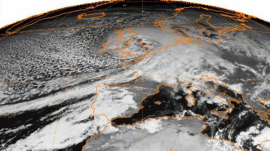Burns' Day Storm
 Burns' Day Storm/Daria 11:30UTC 25 January 1990 | |
| Type | European windstorm, extratropical, extratropical storm surge |
|---|---|
| Formed | 23 January 1990[1] |
| Dissipated | 26 January 1990 |
| Lowest pressure | 949 hPa (28.0 inHg)[1] |
| Highest winds |
|
| Highest gust | 93 kn (172 km/h; 107 mph), Aberporth, Wales and Gwennap Head, Cornwall |
| Fatalities | 47 (Met Office)[2] |
| Areas affected | Ireland, United Kingdom, France, Belgium, Netherlands, West Germany, East Germany, Denmark |
The Burns' Day Storm (also known as Cyclone Daria) was an extremely violent windstorm that took place on 25–26 January 1990 over north-western Europe. It is one of the strongest European windstorms on record. This storm has received different names as there is no official list of such events in Europe. [3] Starting on the birthday of Scottish poet Robert Burns, it caused widespread damage and hurricane-force winds over a wide area. The storm was responsible for 97 deaths (according to the Met Office), although figures have ranged from 89 to over 100.[citation needed]
Contents
1 Meteorological history
1.1 Winds
1.2 Forecasting
2 Impacts
3 See also
4 References
5 External links
Meteorological history
The storm began as a cold front over the Northern Atlantic Ocean on 23 January. By the 24th, it had a minimum central pressure of 992 mbar and began to undergo explosive cyclogenesis, sometimes referred to as a weather bomb.[4] It made landfall on the morning of the 25th over Ireland, where 17 died, including 8 on a bus which was struck by a falling tree. It then tracked over to Ayrshire in Scotland. The lowest pressure of 949 mbar was recorded near Edinburgh around 16:00. After hitting the United Kingdom, the storm tracked rapidly east towards Denmark, causing major damage and 30 deaths in the Netherlands and Belgium.[1]
Winds
The strongest sustained winds recorded were between 70 and 75 mph (110–120 km/h), comparable to a weak Category 1 hurricane or Hurricane-force 12 on the Beaufort Scale. Strong gusts of up to 104 mph (170 km/h;) were reported, and it was these which caused the most extensive damage.
Forecasting
The Burns' Day Storm of 1990 has been given as an example of when the Met Office "got the prediction right".[5] The model forecast hinged on observations from two ships in the Atlantic near the developing storm the day before it reached the UK.[6]
During the day of the storm the Royal Netherlands Meteorological Institute (KNMI) increased warnings to force 11 and eventually to hurricane force 12. Research conducted by them showed that most of the general public were not able to understand the severity of the warnings. The storm has led to more awareness about the understanding of storminess among the public by the KNMI, who started a teletext page and the introduction of special warnings for extreme weather events in reaction to these findings.[7]
Impacts
Casualties were much higher than those of the Great Storm of 1987, because the storm hit during the daytime. The storm caused extensive damage, with approximately 3 million trees downed, power disrupted to over 500,000 homes and severe flooding in England and West Germany. The storm cost insurers in the UK £3.37 billion, the UK's most expensive weather event to insurers.[8] Most of the deaths were caused by collapsing buildings or falling debris. In one case in Sussex, a class of children was evacuated just minutes before their school building collapsed. Actor Gorden Kaye was also injured during the storm, when a plank of an advertising board was blown through his car's windscreen.[9]
See also
Vivian (storm) 25–28 February 1990, later Wiebke . This is called the 1990 storm series.- List of natural disasters in Great Britain and Ireland
- Great Storm of 1987
- European windstorm
References
^ abc McCallum, E. (1990). "The Burn's Day Storm, 25 January 1990". Weather. 45: 166–173. Bibcode:1990Wthr...45..166M. doi:10.1002/j.1477-8696.1990.tb05607.x..mw-parser-output cite.citation{font-style:inherit}.mw-parser-output q{quotes:"""""""'""'"}.mw-parser-output code.cs1-code{color:inherit;background:inherit;border:inherit;padding:inherit}.mw-parser-output .cs1-lock-free a{background:url("//upload.wikimedia.org/wikipedia/commons/thumb/6/65/Lock-green.svg/9px-Lock-green.svg.png")no-repeat;background-position:right .1em center}.mw-parser-output .cs1-lock-limited a,.mw-parser-output .cs1-lock-registration a{background:url("//upload.wikimedia.org/wikipedia/commons/thumb/d/d6/Lock-gray-alt-2.svg/9px-Lock-gray-alt-2.svg.png")no-repeat;background-position:right .1em center}.mw-parser-output .cs1-lock-subscription a{background:url("//upload.wikimedia.org/wikipedia/commons/thumb/a/aa/Lock-red-alt-2.svg/9px-Lock-red-alt-2.svg.png")no-repeat;background-position:right .1em center}.mw-parser-output .cs1-subscription,.mw-parser-output .cs1-registration{color:#555}.mw-parser-output .cs1-subscription span,.mw-parser-output .cs1-registration span{border-bottom:1px dotted;cursor:help}.mw-parser-output .cs1-hidden-error{display:none;font-size:100%}.mw-parser-output .cs1-visible-error{font-size:100%}.mw-parser-output .cs1-subscription,.mw-parser-output .cs1-registration,.mw-parser-output .cs1-format{font-size:95%}.mw-parser-output .cs1-kern-left,.mw-parser-output .cs1-kern-wl-left{padding-left:0.2em}.mw-parser-output .cs1-kern-right,.mw-parser-output .cs1-kern-wl-right{padding-right:0.2em}
^ "Burns' Day Storm - 25 January 1990". Met Office. 15 April 2016. Retrieved 15 September 2018.
^ "Seasonal predictability of European wind storms" (PDF). Institute of Meteorology. Free University of Berlin. 2008. p. 7. Retrieved 21 March 2012.
^ "Daria le 25 janvier 1990 - Tempêtes en France métropolitaine". tempetes.meteofrance.fr (in French). Météo-France. Retrieved 5 November 2017.
^ Adams, Tim (21 February 2010). "Met Office forecasts storm warnings over its accuracy". The Observer. Retrieved 9 February 2013.
^ Heming, J.T. (1990). "The impact of surface and radiosonde observations from two Atlantic ships on a numerical weather prediction model forecast for the storm of 25 January 1990". The Meteorological Magazine. 119: 249–259.
^ "Nader Verklaard Zwaarste storm in decennia". KMNI. Retrieved 9 February 2013.
^ "UK storm payout 'may hit £350m' the storm was really really big". BBC News. 20 February 2007. Retrieved 16 October 2017.High winds that hit the country in the first few weeks of 1990 – costing insurers £3.37bn – remain the most expensive for insurers.
^ "1990: Children killed in devastating storm". On This Day. BBC News. Retrieved 16 October 2017.
External links
- On this Day by the BBC
